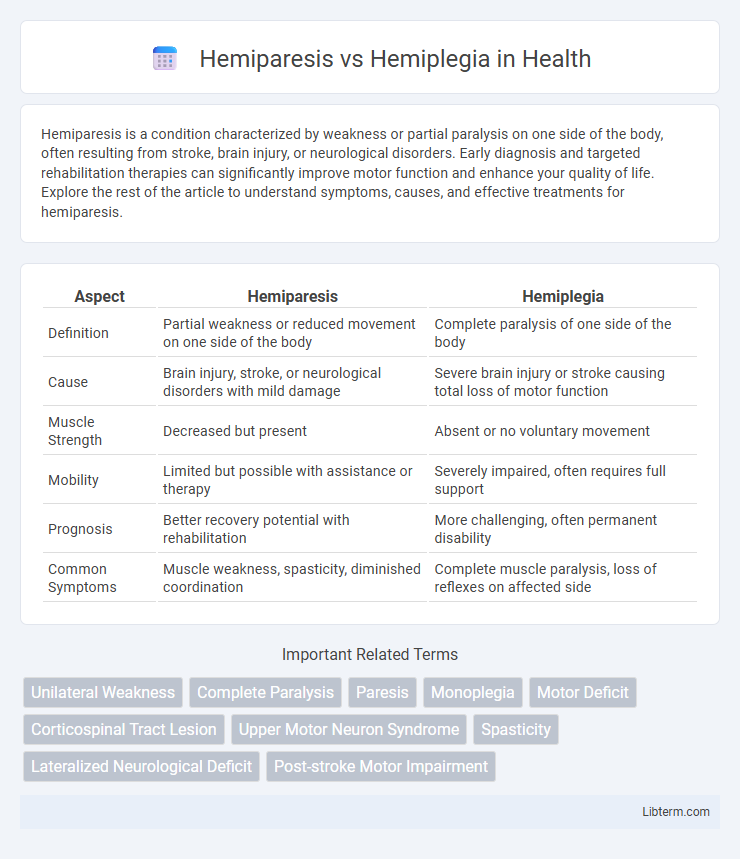Hemiparesis is a condition characterized by weakness or partial paralysis on one side of the body, often resulting from stroke, brain injury, or neurological disorders. Early diagnosis and targeted rehabilitation therapies can significantly improve motor function and enhance your quality of life. Explore the rest of the article to understand symptoms, causes, and effective treatments for hemiparesis.
Table of Comparison
| Aspect | Hemiparesis | Hemiplegia |
|---|---|---|
| Definition | Partial weakness or reduced movement on one side of the body | Complete paralysis of one side of the body |
| Cause | Brain injury, stroke, or neurological disorders with mild damage | Severe brain injury or stroke causing total loss of motor function |
| Muscle Strength | Decreased but present | Absent or no voluntary movement |
| Mobility | Limited but possible with assistance or therapy | Severely impaired, often requires full support |
| Prognosis | Better recovery potential with rehabilitation | More challenging, often permanent disability |
| Common Symptoms | Muscle weakness, spasticity, diminished coordination | Complete muscle paralysis, loss of reflexes on affected side |
Understanding Hemiparesis and Hemiplegia
Hemiparesis and hemiplegia are neurological conditions characterized by weakness and paralysis on one side of the body, respectively, often resulting from stroke, brain injury, or neurological disorders. Hemiparesis involves partial muscle weakness and reduced motor control, affecting daily activities and requiring physical therapy for improvement. Hemiplegia denotes complete paralysis with loss of voluntary movement, necessitating comprehensive rehabilitation and assistive devices for mobility and function restoration.
Key Differences Between Hemiparesis and Hemiplegia
Hemiparesis is characterized by partial weakness or reduced strength on one side of the body, whereas hemiplegia refers to complete paralysis on one side. Hemiparesis allows some voluntary movement and muscle control, while hemiplegia results in total loss of motor function on the affected side. Assessment of muscle strength and motor control helps differentiate hemiparesis from hemiplegia clinically and guides rehabilitation strategies.
Common Causes of Hemiparesis
Hemiparesis, characterized by partial weakness on one side of the body, commonly results from ischemic stroke, traumatic brain injury, multiple sclerosis, or cerebral palsy. In contrast, hemiplegia involves complete paralysis on one side, often due to more severe brain lesions such as large strokes or hemorrhages. Understanding these common causes aids in accurate diagnosis and tailored rehabilitation strategies.
Primary Causes of Hemiplegia
Hemiplegia primarily results from brain injuries such as ischemic stroke, hemorrhagic stroke, traumatic brain injury, and cerebral palsy, which disrupt motor function on one side of the body. Other significant causes include brain tumors, infections like encephalitis, and neurodegenerative diseases affecting motor pathways. Understanding these etiologies is crucial for targeted treatment and rehabilitation strategies.
Signs and Symptoms Comparison
Hemiparesis presents as partial weakness or reduced motor function on one side of the body, often including decreased muscle strength and impaired fine motor skills, while hemiplegia involves complete paralysis on one side, leading to total loss of voluntary muscle movement. Both conditions may feature associated signs such as spasticity, abnormal reflexes, and sensory deficits, but hemiparesis typically allows some degree of movement and control. Differences in severity impact rehabilitation approaches and functional outcomes, with hemiplegia requiring more intensive interventions to address severe motor impairments.
Diagnosis: Hemiparesis vs Hemiplegia
Hemiparesis diagnosis involves clinical assessment of partial muscle weakness on one side of the body, often confirmed through strength testing and neurological examination. Hemiplegia diagnosis requires identifying complete paralysis on one side, typically evaluated by motor function scales and imaging techniques such as MRI or CT scans to determine underlying brain injury. Differentiating between hemiparesis and hemiplegia is crucial for tailoring rehabilitation strategies and predicting patient recovery outcomes.
Treatment Options for Hemiparesis
Treatment options for hemiparesis primarily include physical therapy to improve motor function and strength on the affected side, occupational therapy to enhance daily living skills, and speech therapy if communication is impacted. Pharmacological interventions may involve muscle relaxants like baclofen or tizanidine to reduce spasticity, while electrical stimulation techniques can promote muscle activation and neuroplasticity. Advanced therapies such as constraint-induced movement therapy (CIMT) and robotic-assisted rehabilitation are increasingly employed to maximize recovery and functional independence in patients with hemiparesis.
Hemiplegia: Treatment and Rehabilitation
Hemiplegia involves complete paralysis of one side of the body, requiring intensive treatment focused on restoring mobility and preventing complications. Rehabilitation typically includes physical therapy to improve muscle strength and coordination, occupational therapy to enhance daily living skills, and speech therapy if communication or swallowing is affected. Use of assistive devices, neuromuscular electrical stimulation, and tailored exercise programs are critical components to optimize functional recovery and enhance quality of life.
Prognosis and Recovery Outcomes
Hemiparesis, characterized by partial weakness on one side of the body, generally has a more favorable prognosis and potential for functional recovery compared to hemiplegia, which involves complete paralysis on one side. Recovery outcomes for hemiparesis benefit significantly from early and intensive rehabilitation interventions, often resulting in improved motor control and independence. Conversely, hemiplegia usually requires longer-term therapy with slower and less complete recovery, especially when associated with extensive brain injury or stroke severity.
Living with Hemiparesis or Hemiplegia
Living with hemiparesis or hemiplegia involves adapting to varying degrees of muscle weakness or paralysis on one side of the body, impacting mobility and daily activities. Rehabilitation strategies such as physical therapy, occupational therapy, and assistive devices enhance independence and improve quality of life for individuals affected by these neurological conditions. Consistent medical follow-up and personalized care plans are crucial to managing symptoms and preventing complications like muscle stiffness or contractures.
Hemiparesis Infographic

 libterm.com
libterm.com